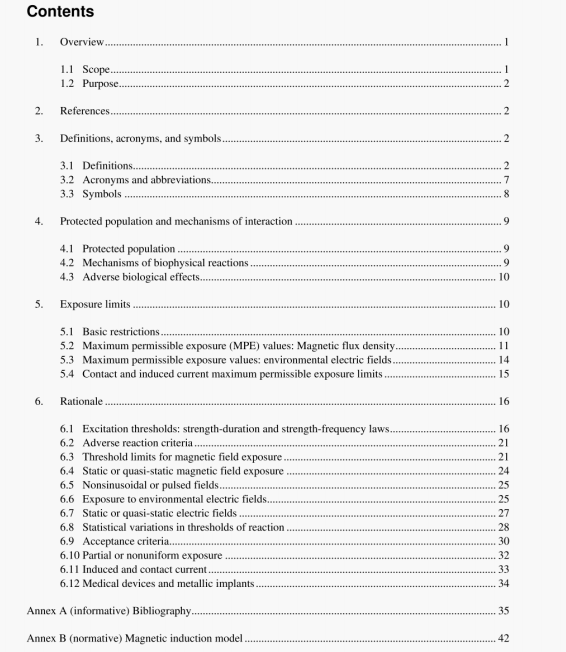IEEE Std C95.6:2002 pdf free download.IEEE Standard for Safety Levels with Respect to Human Exposure to Electromagnetic Fields, 0- 3 kHz.
Cardiac excitation is not necessarily hazardous, although ventricular fibrillation (VF) is a serious life- threatening condition. Minimum thresholds tbr VF typically exceed those for excitation by a factor of 50 or more. However, if the heart is repeatedly excited, the VF threshold drops such that the margin between VF and excitation thresholds may be reduced to a factor as little as two if the stimulus is applied during the vulnerable period within the cardiac cycle.
Cardiac excitation would not be an exposure issue under most circumstances since with exposure of the tors) the limits on peripheral nerve excitation would prevail. However, particular circumstances of nonunifiwm exposure that result in strong induced fields around the heart could conceivably require the application of thc cardiac excitation criterion.
6.1.3 Synaptic activity alteration
Whereas the nerve cell requires membrane depolaritation of approximately 15—20 mV to initiate an action potential. synaptic processes can be affected by altering the presynaptic membrane potential by less than 1 mV. and possibly as little as 60 pV. as with electrical stimulation of synapses in the retina (Knighton [B53]. 1B541—a facor 250 Limes lofler than minimum neural excitation thresholds. Consequently, the synapse is a potentially sensitive site for neural interaction with applied electrical stimulate. An importam property of the synapse is that a relatively small change in presynaplic potential can have a much larger percentage change in postsynaptic potentials Katz and Miledi [B50]). Since the possynaptic cell sums the presynaptic inputs from several cells, a small change in presynaplic potential can have a significant pos(synaptic effect, and can be either inhibitory or exCitatory, i.e.. could result in the excitation of’ a neuron that would otherwise not have been excited, or could inhibit excitation of a neuron that would otherwise have been excited.
An example of a synaptic polarization effect is attributed to the phenomenon of electro- and magnetophosphenes. which are visual effects resulting from electric currents or magnetic fields applied to the head (Adrian (B2 Barlow [B51], [B61]; Baumgart [B71]; Bergeron et al. [B1O]; Budingeret al. [B19]; Carstensen
IB2ll: Clausen [B24]; Lövsund et al. [B57], IB5X1; Silny [B92]. Experimental evidence suggests that phosphenes result from modification of synaptic potentials in the receptors and neurons ot’ the retina (Knighton [B53]. [B54]: Lövsund et al. [B57]), rather than excitation of the optic nerve or the visual cortex, although visual sensations with stimulation of the visual cortex have been demonstrated with much stronger stimuli Brindley and Lewin [B17]; Brindley and Rushton IBIXI: Ronner [B83]).
IEEE Std C95.6:2002 pdf free download
